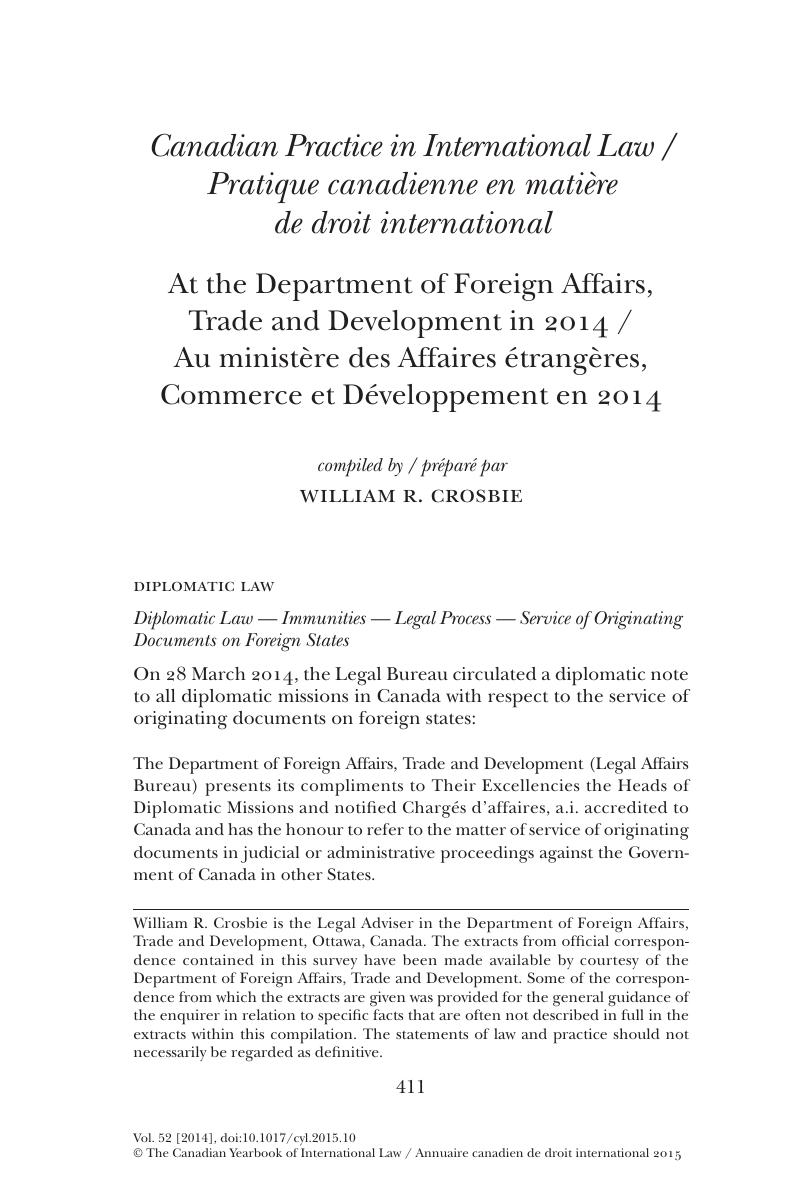No CrossRef data available.
Article contents
At the Department of Foreign Affairs, Trade and Development in 2014 / Au ministère des Affaires étrangères, Commerce et Développement en 2014
Published online by Cambridge University Press: 17 November 2015
Abstract

- Type
- Canadian Practice in International Law / Pratique canadienne en matière de droit international
- Information
- Canadian Yearbook of International Law/Annuaire canadien de droit international , Volume 52 , October 2015 , pp. 411 - 436
- Copyright
- Copyright © The Canadian Yearbook of International Law/Annuaire canadien de droit international 2015
References
1 Gerald L Neuman, Revised Draft Prepared by the Rapporteur for General Comment No 35, Doc CCPR/C/GC/R.35/Rev.3 (10 April 2014), online: <http://www.ohchr.org/EN/HRBodies/CCPR/Pages/DGCArticle9.aspx>.
2 Panel Report, EC – Seal Products at para 7.650.
3 Ibid at para 7.644, referring to the Appellate Body Report in US – Shrimp at para 150. The three situations are: (a) arbitrary discrimination between countries where the same conditions prevail; (b) unjustifiable discrimination between countries where the same conditions prevail; or (c) a disguised restriction on international trade.
4 Panel Report, EC – Seal Products at para 7.649.
5 See Appellate Body Report, US – Clove Cigarettes at paras 91–101.
6 Panel Report, EC – Seal Products at para 7.258.
7 Appellate Body Report, US – COOL at para 271.
8 Panel Report, EC – Seal Products at para 7.649.
9 VCLT, art 31(1).
10 Appellate Body Report, US – Clove Cigarettes at paras 90-91, referring to Panel Report, EC – Seal Products at para 7.582.
11 Panel Report, EC – Seal Products at para 7.259.
12 Appellate Body Report, Brazil – Retreaded Tyres at para 228.
13 Ibid.
14 European Union’s other appellant submission at paras 288–90.
15 Appellate Body Report, Dominican Republic – Import and Sale of Cigarettes at para 96.
16 Appellate Body Report, US – Clove Cigarettes at para 179, n 372.
17 Ibid.
18 Ibid at para 179.
19 Ibid at para 181.
20 Appellate Body Report, US – Anti-Dumping and Countervailing Duties (China) at para 285.
21 See, for example, Appellate Body Report, Korea–Dairy at para 80.
22 Panel Report, US – Carbon Steel (India) at paras 7.83, 7.87.
23 The six factors identified by the Compliance Panel are:
-
a. the amended COOL measure’s degree of contribution to a legitimate objective;
-
b. the trade-restrictiveness of the amended COOL measure;
-
c. the nature of the risks at issue and the gravity of consequences that would arise from non-fulfilment of the objective pursued by the United States through the amended COOL measure;
-
d. whether the alternatives proposed by the complainants are less trade restrictive than the amended COOL measure;
-
e. whether the proposed alternatives would make an equivalent contribution to the relevant legitimate objective, taking account of the risks non-fulfilment would create; and
-
f. whether the proposed alternatives are reasonably available.
See Panel Reports, US – COOL (Article 21.5 – Canada and Mexico) at para 7.303.
24 Ibid at para 7.311.
25 Ibid at para 7.417.
26 Original Panel Reports, US – COOL at paras 7.581 and 7.637. That said, the USDA stated that information on production steps in each country “may embody latent (hidden or unobservable) attributes, which may be important to individual consumers and result in additional but hard to measure benefit increases” (2013 Final Rule, Exhibit CDA-1 at 31377). If these “attributes” were a veiled reference to food safety concerns, requiring the provision of information on such attributes would be at odds with the United States’ explanations in the original dispute that the COOL measure is not related to food safety.
27 Canada’s first written submission to the Compliance Panel at para 145.
28 Panel Reports, US – COOL (Article 21.5 – Canada and Mexico) at para 6.59.
29 Ibid.
30 Ibid at paras 7.423–7.424.
31 Ibid at para 7.417.
32 Ibid at para 7.258. See also Original Panel Reports, US – COOL at para 7.606.
33 Panel Reports, US – COOL (Article 21.5 – Canada and Mexico) at para 7.418.
34 Ibid at para 6.59.
35 2013 Final Rule, Exhibit CDA-1 at 31377. The USDA explained that:
Comments received on the 2009 final rule and previous requests for comments elicited no evidence of significant barriers to the provision of this information other than private costs to firms and low expected returns. Thus, from the point of view of society, such evidence suggests that market mechanisms could ensure that the optimal level of country of origin information would be provided to the degree valued by consumers (2013 Final Rule, Exhibit CDA-1 at 31377) (emphasis added).
36 Canada’s first written submission to the Compliance Panel at para 142.
37 Appellate Body Reports, US – COOL at paras 478–79.


